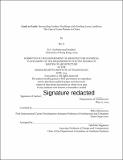Earth to Earth : reconciling earthen dwellings with eroding loess landform : the case of Loess Plateau in China
Author(s)
Li, Bin, M. Arch. Massachusetts Institute of Technology
DownloadFull printable version (102.0Mb)
Alternative title
Reconciling earthen dwellings with eroding loess landform
Other Contributors
Massachusetts Institute of Technology. Department of Architecture.
Advisor
Miho Mazereeuw.
Terms of use
Metadata
Show full item recordAbstract
Ten percent of the earth's land surface area is covered with loess deposits, a type of highly erodible soil consisting of less than 20% clay. Loess soil has topped eroding hills and valleys and supported an earthen construction tradition in loess landform territories. The Loess Plateau in China has been suffering from heavy soil erosion. Soil erosion is caused by the scale of the hill and valley watershed and exacerbated by the scale of earthen dwellings. These dwellings are mostly populated by low-income agricultural households. They obtain soil resources from exposed loess sections and build dwellings on nearby flat land. This approach increases erosion to both the landforms and the dwellings, and worsens the living quality of the local residents. Nevertheless, considering affordability, environmental load, and soil stabilization, local soil and natural fiber are good choices of building material. Can earthen dwellings be designed so as not to increase soil erosion but to reconcile their relationship to the eroding landform? Meanwhile, can vegetated landforms be designed to contribute to the built form? If so, how? In this design thesis, I show that considering the landform and the built form as a whole is the key to resolve the loess soil erosion problem. Vegetation and grading can be designed to extend from the ridge, to the terraced land, and to the gully slopes to control soil erosion. Five new earthen dwelling types can be introduced, according to various degrees of uncontrolled slopes, in order to reduce both exposed soil sections and earthen walls and not exacerbate soil erosion in the future. Settlements can be upgraded as a result of negotiation between the landforms and the built forms. Such a settlement can triple the number of households to help meet the demand for replacing decrepit houses and for hosting younger families. The scaling-in research method from the globe to a single dwelling and the design sequence of landscape, dwelling, and settlement together constitute an innovative approach to addressing a complex problem.
Description
Thesis: M. Arch., Massachusetts Institute of Technology, Department of Architecture, 2014. This electronic version was submitted by the student author. The certified thesis is available in the Institute Archives and Special Collections. Cataloged from student-submitted PDF version of thesis. Includes bibliographical references (page 124).
Date issued
2014Department
Massachusetts Institute of Technology. Department of ArchitecturePublisher
Massachusetts Institute of Technology
Keywords
Architecture.